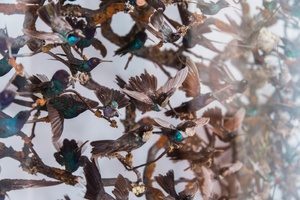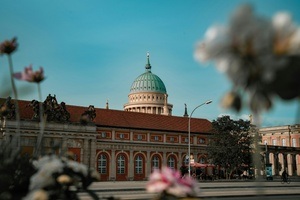Sahar Zukerman - OMEN
In the organizer's words:
From June 29 to August 3, 2025, the Kunstraum Potsdam / Waschhaus is showing "Omen", a large-scale solo exhibition by the artist Sahar Zukerman (*1985 London, UK, grew up in Tel Aviv, lives in Berlin). Zukerman paints painterly, masterful, richly filled pictorial worlds. Motifs glow and radiate: a powerful lion, a bright yellow ice cream, a magnificent crown. The shimmering surface, the generous, skillful painting style and the richness of figures and colors seduce and captivate. Zukerman's artistic virtuosity is also a concept. For there is fire, lightning and thunder, danger is imminent. Disaster is brewing in the midst of beautiful appearances. Zukerman tells political, pop-cultural and biblical stories that demonstrate the duality of our time. These are motivic set pieces from thousands of years of Jewish, Christian and Muslim cultural history, which the artist knows from his personal life experience. In the Omen exhibition, Zukerman is showing a series of new works that continue this artistic exploration. Omen-like, they perceive the social trends of our time and show a foreboding, ambivalent but never hopeless view of the future.
"I generally think that my job as an artist is to bring even more imagination into the world. In other words, to open up another or at least an additional view and to create an emotional effect; to trigger movement or touch."
Sahar Zukerman
The exhibition will focus in particular on three new groups of works. Galactic Zionator, since 2019 and continuing, is a series of over 100 works on paper. The title refers humorously to two references: firstly to "Global Zionism" as a contemporary reiteration of a long-lived anti-Semitic conspiracy theory, and secondly to the "Terminator" as a pop-cultural sci-fi action film classic. Zukerman shifts the power of interpretation in his favor and appropriates the anti-Semitic motif in deep black Jewish humor. The "Zionators" become (desperately) comic heroes of fiction, in the spirit of Dracula, Loch Ness or Bigfoot.
Promised Land is a group of large-format paintings that dream of an ideal world where there is no more evil. It is a declaration of love for a "promised land" of peace and harmony, but it asks doubtfully what such a land would look like and who would inhabit it. It illustrates how this fantasy of peace, belonging and happiness is appropriated by nationalism. Zukerman deals with the longing for home and belonging, the feeling of being a stranger in one's own country, and the dissonance between man and nature. Experiences of diaspora and immigration, flight and exile are deeply inscribed in the group of works. It opens up a differentiated image of identity and belonging, transcending national and cultural borders. The reflection on identity and tradition is reinforced in a special way in the exhibition "Omen", as a conscious connection is made to contemporary Jewish life in Potsdam: In addition to Zukerman's works, loans from the Jewish community in Potsdam are on display. The works of art communicate with the objects from the synagogue and draw a wide-ranging arc to Jewish cultural and art history: a Torah crown from the Jewish synagogue, which is also found in Zukerman's work, is also on display.
Burning Bush, the burning bush as an Old Testament motif, also recurs several times in Zukerman's work. For the artist, it is the emblem par excellence of ambivalence and the conflict in the Middle East. The burning bush has many sides, many truths - for Zukerman a metaphor for his own upbringing in Israel. The thorn bush represents a cycle of destruction and reconstruction, of never-ending hope followed by violence and so on. In Zukerman's works, it sometimes appears as a flower, or even as a toaster and ice, always enveloped in flames. Often, however, it is an olive tree - a plant that is important to all Abrahamic religions in the Middle East and beyond. Its image connects the cultures. It illustrates what they have in common and sets an example for what they share; combined with a little hope for the future.
Sahar Zukerman (*1985 London, UK) grew up in Tel Aviv and lives in Berlin. He studied from 2007 to 2008 at the Jerusalem Studio School with Eldar Faber and Israel Hershberg and from 2009 to 2014 at the Berlin University of the Arts with Leiko Ikemura. His works have been shown in numerous international solo and group exhibitions, including in Vienna, Berlin, Jerusalem, Tel Aviv, London, Moscow, Cologne, Leipzig and Dresden.
Text, Dr. Kristina Schrei
This content has been machine translated.













